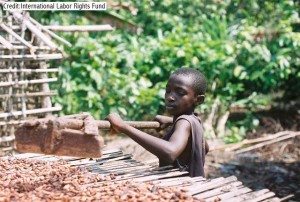
By Dow-Yung Kou, LuxEco Editorial Assistant
“Life is like a box of chocolates… you never know what you’re gonna get. ” – Forrest Gump
Forrest Gump may have been on to something when he compared life to chocolates. You really never know what you’re gonna get in a box of chocolates, do you? When you’re lucky, you may get one that has a salted caramel center, and another with almond praline sprinkles. But sometimes, just when you’re expecting your usual delight, you get that kind with the dark hollow chocolate shell that’s fluffed full of slavery.
Maybe when purchasing a box we should look beyond the assortment of delectable chocolates, and instead consider, how much slavery went into this?
The truth behind chocolate is more bitter than sweet. The Ivory Coast produces 40% of the world’s chocolate, and it just so happens to also be notorious for this little thing called child slavery. Children, both local and from other third world countries, are sold to farms in this area where they are physically abused while working in risky and inhumane conditions. Some children are sold into the trade by parents who are tricked into believing their children will have better lives at the farm. Others are trafficked, stolen from their families, lured by the promise of…chocolate. In these farms they are forced to work 60 hour weeks with little or no food (depending on their performance on the field). These children lose their fundamental human rights when they enter these farms and “modern” society turns a blind eye to the atrocities. Every time we buy a box of chocolate that is not fair trade stamped, we (often unknowingly) endorse child slavery.
You might ask why, if this violation is so prevalent in the Ivory Coast, hasn’t scandal broken out similar to that in the case of NIKE’s outsourced sweatshops? The answer is, they have, but without visibility in the media the issue falls on deaf ears. Additionally, farms supply to middlemen who supply to large corporations. By the time the cocoa is processed and reaches the consumer, it has exchanged so many hands that it is virtually impossible to trace its origins. With this lack of transparency in the system, the chocolate industry cannot confirm or deny its hand in child slavery. Companies know only that “some” of their chocolate is slavery produced, but since there is no way to trace it, they choose to do little to respond to the accusations. In 2005, the industry came out and said that they would work toward better managing its chocolate sources, but until recently it hasn’t showed.
Our cultural values have shifted to an “ignorance is bliss” take on consumption. It is often the consumer that pushes the cocoa farmers and the chocolate industry into a corner. In order to be competitive, manufactures feel the need to use child slavery. It seems that as long as we can’t see the human rights violations, the pesticide use, the carbon footprint, the toxic waste and the pollution… we will choose to indulge in the cheap. We only act when we are caught; we only act when the problem becomes social taboo. What really defines our privileged lives then? Is it the luxury to buy whatever we want at the cheapest price possible–even at someone else’s expense, or is luxury defined by how responsible and healthy we live our lives?
On Monday, September 13, 2010 the chocolate industry finally woke up from its five year slumber and pledged $7 million to end the child labor violations in the Ivory Coast. Their call to action brings hope that slowly but surely, the industry is moving toward better Corporate Social Responsibility (CSR), but ultimately it is up to us as consumers to really stand up for human rights and choose fair trade.
Be an aware and informed citizen of the world, and perhaps life and chocolate will taste just a little sweeter that way.














Hello dowyung
This is a very interesting article.
Child labor should be stopped in the world , It is cruelty to children
Child labor = Slavery
Visit the Picture of Child labor In : http://www.nsun.us
Thank you